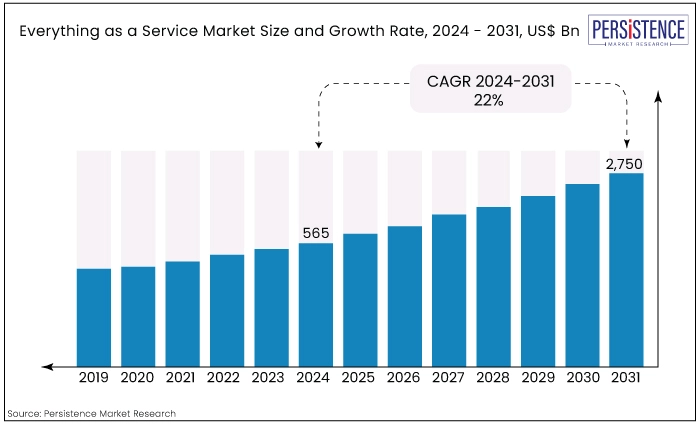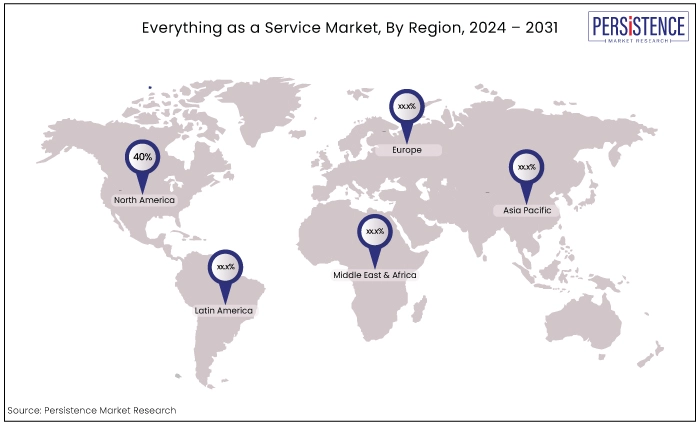Industry: Semiconductor Electronics
Format: PPT*, PDF, EXCEL
Delivery Timelines: Contact Sales
Report Type: Ongoing
Report ID: PMRREP32616
The everything as a service market is estimated to reach a valuation of US$2750 billion by the year 2031, at a CAGR of 22%, during the forecast period 2024 to 2031.
Key Highlights of the Market
|
Attributes |
Key Insights |
|
Market Value (2024) |
US$565 Bn |
|
Market Size (2031) |
US$2,750 Bn |
|
Forecast Growth Rate (CAGR 2024 to 2031) |
22% |
|
Historical Growth Rate (CAGR 2019 to 2023) |
4.8% |
The everything-as-a-service (XaaS) market growth is projected to occur at a CAGR of 22% during the forecast period of 2024-2031. Everything as a Service (XaaS), refers to a wide range of software services and applications that are provided to consumers over the Internet.
XaaS refers to a broad range of subscription-based services that are associated with cloud computing and remote access. Businesses are enhancing the cost structure and accelerating the development of new applications and business procedures with the assistance of XaaS.
Enterprises are embracing cloud services to achieve optimal scalability and flexibility in carrying out their operations.
The expansion of the everything-as-a-service market is being driven by the increasing demand of businesses for cloud-based architecture. Further the increased adoption of Xaas-based solutions across a diverse industrial portfolio is a growing trend for the market.
Consumers favour the pricing structure of subscription-based services when selecting the most suitable technology and services. Subscribers of service-based models have the opportunity to allocate their investments in different IT funds for operational purposes.
The growing utilization of Xaas-based solutions in many industries can be attributed to the decreased total cost of ownership, which is advantageous for businesses. The shift in focus towards operational spending will generate a requirement for tailored XaaS solutions that align with specific needs.

The historical period from 2019 to 2023 marked a transformative phase for the Everything as a Service market, characterized by rapid expansion, technological innovation, and widespread adoption across industries globally.
As businesses continue to embrace cloud-centric strategies, the XaaS market share is expected to evolve further, offering new opportunities and challenges in the years to come.
In 2019, the XaaS market began to gain traction as businesses sought to leverage the flexibility and scalability offered by cloud-based services.
Companies started exploring XaaS solutions such as Software as a Service (SaaS), Platform as a Service (PaaS), and Infrastructure as a Service (IaaS) to streamline operations, reduce IT costs, and enhance overall efficiency.
Post-pandemic recovery, and ongoing digital transformation initiatives continued to drive the expansion of the XaaS market into 2022 and 2023.
Enterprises across sectors prioritized cloud-native solutions to innovate their business models, enhance customer experiences, and optimize resource utilization.
The everything-as-a-service market further diversified with the emergence of specialized XaaS offerings tailored to specific industry needs, such as XaaS for healthcare, finance, and manufacturing sectors.
Growing Demand for Enhanced Business Operations
Organizations globally are swiftly transitioning their workloads from traditional infrastructure to cloud-based platforms.
Cloud-based services and solutions assist organizations in enhancing consumer interaction and optimizing corporate operations.
Cloud-based services, such as software and platforms, enable organizations to enhance workforce productivity, decrease total expenses, and provide superior support and maintenance.
The global everything-as-a-service market is seeing expansion due to the swift adoption of diverse cloud-based services aimed at modernizing business operations and enhancing customer experience.
Digital Transformation Initiatives
In an era dominated by digitalization, organizations are increasingly embracing XaaS solutions to facilitate their digital transformation journeys.
XaaS enables businesses to transition from traditional IT infrastructure models to agile, cloud-based environments. This shift empowers companies to innovate faster, respond to market changes more swiftly, and enhance overall operational efficiency.
As enterprises strive to stay competitive in a digital-first landscape, XaaS provides the foundational technology stack necessary to drive innovation and meet evolving customer expectations.
Growing Ubiquity of Remote Work Policies
Hybrid and multi-cloud strategies have become more common as firms aim to optimize their IT environments. Hybrid cloud solutions, which combine private and public cloud resources, offer XaaS options.
Such solutions allow for secure management of workloads and data across many environments, providing flexibility and resilience. This method not only improves operational flexibility but also reduces the risks related to being dependent on a single provider and guarantees adherence to regulatory obligations in various geographical areas.
Data Privacy Concerns
Security and privacy remain paramount concerns for organizations considering or already utilizing XaaS solutions.
While cloud service providers implement stringent security measures, including data encryption, access controls, and compliance with industry standards (e.g., GDPR, HIPAA), concerns persist regarding data breaches, unauthorized access, and potential loss of sensitive information.
Despite robust security protocols, cloud environments can be vulnerable to cyberattacks, leading to data breaches and unauthorized access. High-profile incidents have raised awareness about the risks associated with storing sensitive data in the cloud.
Different regions have varying data protection laws and regulations, necessitating compliance with multiple frameworks. Ensuring adherence to these regulations can be complex and costly for organizations operating in global markets.
Some organizations prefer to retain control over where their data is stored and processed due to regulatory requirements or internal policies. Cloud providers may offer options for data localization, but this adds complexity to managing data across distributed environments, which eventually restricts the everything as a service market growth.
Integration, and Interoperability
Incorporating everything as a service solution into the current IT infrastructure and guaranteeing compatibility with other apps and systems might present considerable difficulties.
Organizations frequently encounter challenges when it comes to integrating everything as a service solution with existing systems, ensuring that data remains consistent across different platforms, and enabling smooth and uninterrupted operations.
Integration of XaaS solutions with legacy systems or other cloud platforms may not always be seamless, resulting in compatibility challenges and necessitating additional resources for customization and integration endeavours.
Migrating data and apps to XaaS environments necessitate meticulous planning to prevent disruptions to business operations and guarantee data integrity. Elaborate data migration procedures can cause delays in the implementation schedule and lead to higher expenses.
Organizations that utilize various XaaS providers or integrate XaaS with on-premises systems may face interoperability difficulties, including problems with data synchronization or inconsistent performance across different environments.
Although XaaS provides scalability and flexibility, it may have limited customization possibilities compared to on-premises solutions. This limitation could prevent enterprises from modifying services to meet unique business demands or industry regulations, which eventually limits the growth of the everything as a service market.
Expansion of Hybrid & Multi-Cloud Solutions
The adoption of hybrid and multi-cloud strategies is expected to increase significantly in the coming years. Hybrid cloud solutions combine private and public cloud environments, allowing organizations to balance workload requirements, optimize performance, and enhance data security.
Multi-cloud architectures, on the other hand, enable businesses to leverage services from multiple cloud providers, reducing dependency on a single vendor and enhancing flexibility.
Further, it is predicted that there will be a growing demand for specialized integration services that enable seamless connectivity and interoperability across different cloud platforms.
Everything as a Service providers offering robust security solutions, including data encryption, identity management, and compliance management tools, will be well-positioned to capitalize on heightened security concerns in hybrid and multi-cloud environments.
As organizations seek to optimize costs associated with cloud deployments, there will be opportunities for service providers to offer cost management and optimization tools, helping businesses achieve greater efficiency and resource utilization.
SaaS Type Services Lead with 38% Market Share
|
Market Segment by Type |
Market Value Share 2024 |
|
SaaS |
38% |
Based on type, the global everything as a service market is further segmented as SaaS, IaaS, PaaS, where the SaaS segment dominates the market share. The segment is projected to expand as the IT and telecommunication industries increasingly utilize SaaS systems, owing to the increased internet user stats the growing utilization of cloud services and the increased volumes of data generation.
Further, as cloud computing becomes more popular, experts in the industry anticipate that Infrastructure-as-a-Service (IaaS) will offer profitable prospects in the next years.
In addition to small and mid-size organizations, governments are also expected to show a growing interest in Infrastructure as a Service (IaaS) due to its great flexibility, extensive network connectivity, on-demand self-service, and scalability.
Large Enterprises Contribute 62% of Total Adoption
|
Market Segment by Enterprise |
Market Value Share 2023 |
|
Large Enterprise |
62% |
Based on enterprise, the market is further sub-segmented into small & medium enterprise and large enterprise, where the large enterprise segment dominates the global everything as a service market share.
Large enterprises are anticipated to rely on the Everything as a Service model to accelerate innovation, decrease ownership costs, and enhance flexibility.
Everything as a Service market has experienced an increase to broaden its customer base, optimize remote operations, allocate resources to more valuable initiatives, and enhance operational efficiency.
The model is positioned to create innovative sources of income and deliver solutions that prioritize the needs and preferences of customers.
North America’s Leadership Position Prevails
|
Region |
Market Value Share 2023 |
|
North America |
40% |
The North American region held the largest market share, with a revenue, owing to the established companies, and new businesses that have expanded their collections of products and services in the US, and Canada, taking advantage of technology improvements in various industries.
In addition, the increasing use of smart devices, and the growing trend of bring-your-own-device (BYOD) have positively influenced the expansion of the North American market.
Stakeholders have shown a growing preference for the security as a service (SECaaS) platform. The primary factor driving the growth trajectory is the significant increase in cyber threats, leading to a subsequent demand for encryption, authentication, and anti-virus software.

October 2022
Oracle Corporation, one of the leading firms globally, launched its new product called Oracle Alloy, which is a cloud infrastructure platform that lets businesses use their own data centres and hardware to build and deploy custom cloud services.
September 2023
Amazon Web Services launched AWS Outposts with new compute instances and expanded storage options, enabling hybrid cloud deployments.
January 2024
IBM Cloud, a branch of IBM, one of the leading tech organizations, formed strategic alliances with leading industry partners to accelerate hybrid cloud adoption and digital transformation initiatives.
The competitive landscape of the global everything as a service market is characterized by innovation, strategic partnerships, and a relentless focus on customer-centric solutions.
As competition intensifies, key players continue to differentiate themselves through advanced technologies, global infrastructure expansion, and industry-specific expertise, shaping the future of cloud computing and digital services worldwide.
|
Attributes |
Details |
|
Forecast Period |
2023 - 2031 |
|
Historical Data Available for |
2019 - 2023 |
|
Market Analysis |
US$ Billion for Value |
|
Key Regions Covered |
|
|
Key Companies Profiled |
|
|
Pricing |
Available upon request |
By Type
By Enterprise
By Industry
By Region
To know more about delivery timeline for this report Contact Sales

Software as a service is the highly demanded type of service
The XaaS market is segmented based on type, enterprise, and industry.
North America holds a significant market share due to the presence of major companies in the region.
McAfee, LLC, Microsoft, Oracle, Oracle, Adobe Inc., Amazon Web Services, are some of the top key players in the industry.
The everything as a service is estimated to exhibit a CAGR of 22% over the forecast period.